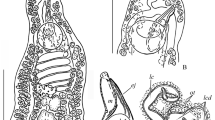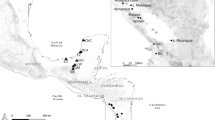Abstract
The systematic relationships of aspinose allocreadiid-like digeneans from Middle-American and Neotropical freshwater fishes, such as Wallinia Pearse, 1920, Margotrema Lamothe-Argumedo, 1970, Magnivitellinum Kloss, 1966 and other related genera, remain enigmatic. Wallinia (2 spp.) and Margotrema (2 spp.) have been placed in the subfamily Walliniinae, within the Macroderoididae. Recent descriptions of species in these genera have followed this classification but have raised questions about their affinities with macroderoidids. Partial sequences of the 28S rRNA gene of Wallinia chavarriae Choudhury, Hartvigsen & Brooks, 2002 and Margotrema bravoae Lamothe Argumedo, 1970, as representatives of their genera, were used in a phylogenetic analysis along with the available sequences of macroderoidids and allocreadiids. Results from Maximum Parsimony, Maximum Likelihood and Bayesian Analyses were identical in placing both genera into one clade along with allocreadiids rather than the macroderoidids. Margotrema was the sister group of Crepidostomum Braun, 1900, and Wallinia was the sister group of both Margotrema and Crepidostomum combined. Bootstrap and Bremer values, as well as posterior probabilities derived from Bayesian analysis strongly supported these relationships in three analyses.



Similar content being viewed by others
References
Brooks, D. R., & McLennan, D. A. (1993). Parascript. Parasites and the language of evolution (pp. 429). Washington, DC: Smithsonian Institution Press.
Caira, J. N. (1989). A revision of the North American papillose Allocreadiidae (Digenea) with independent cladistic analyses of larval and adult forms. Bulletin of the University of Nebraska State Museum, 11, 195.
Caira, J. N., & Bogéa, T. (2005), Family Allocreadiidae. In A. Jones, R. A. Bray, & D. I. Gibson (Eds.), Keys to the Trematoda (Vol. 2, pp. 768). Wallingford: Commonwealth Agricultural Bureaux International.
Choudhury, A., Hartigsen-Daverdin, R., & Brooks, D. R. (2002). Wallinia chavarriae n. sp. (Trematoda: Macroderoididae) in Astyanax aenaeus (Günther, 1860) and Bryconamericus scleroparius (Regan, 1908) (Osteichthyes: Characidae) from the Area de Conservación Guanacaste, Costa Rica. Journal of Parasitology, 88, 107–112.
Choudhury, A., & León-Règagnon, V. (2005). Molecular phylogenetics and biogeography of Bunodera spp (Trematoda: Allocreadiidae), parasites of percid and gasterosteid fishes. Canadian Journal of Zoology, 83, 1540–1546.
Choudhury, A., Rosas-Valdez, R., Johnson R. C., Hoffman B., & Pérez-Ponce de León, G. (2007). The phylogenetic position of the Allocreadiidae (Trematoda: Digenea) using partial sequences of the 18S and 28S ribosomal genes. Journal of Parasitology (in press).
Hall, T. A. (1999). BioEdit: a user-friendly biological sequence alignment editor and analysis program for Windows 95/98/NT. Nucleic Acids Symposium Series, 41, 95–98.
Hillis, D., & Dixon, T. M. (1991). Ribosomal DNA: Molecular evolution and phylogenetic inference. The Quarterly Review of Biology, 66, 411–453.
Hillis, D. M., Mable, B. K., & Moritz, C. (1996). Nucleic acids IV: Sequencing and cloning. In D. M. Hillis, C. Moritz, & B. K. Mable (Eds.), Molecular Systematics (pp. 321–383). Sunderland, Massachussets: Sinauer.
Hopkins, S. H. (1934). Studies on Crepidostomum. III. Crepidostomum brevivitellum n. sp. Journal of Parasitology, 20, 295–298.
Huelsenbeck, J. P., & Ronquist, F. (2001). MrBayes: Bayesian inference of Phylogenetic trees. Bioinformatics, 17, 754–755.
Hoffman, G. L. (1999). Parasites of North American freshwater fishes (pp. 539). Ithaca, NY: Cornell University Press.
Lamothe-Argumedo, R. (1970). Trematodos de Peces VI. Margotrema bravoae gen. nov. sp. nov. (Trematoda: Allocreadiidae), parásito de Lermichthys multiradiatus Meek. Anales del Instituto de Biología. Anales del Instituto de Biología Universidad Nacional Autónoma de México, Serie Zoología, 41, 87–92.
Mejía-Madrid, H., Domínguez-Domínguez, O., & Pérez-Ponce de León, G. (2005). Adult endohelminth parasites of Goodeinae (Cyprinodontiformes: Goodeidae) from Mexico, with some biogeographical considerations. Comparative Parasitology 72, 200–211.
Olson, P. D., Cribb, T. H., Tkach, V. V., Bray, R. A., & Littlewood, D. T. J. (2003). Phylogeny and classification of the Digenea (Platyhelminthes: Trematoda). International Journal for Parasitology, 33,733–755.
Palumbi, S. R. (1996). Nucleic acids II: The polymerase chain reaction. In D. M. Hillis, C. Moritz, & B. K. Mable (Eds.), Molecular Systematics (pp. 205–247). Sunderland, Massachusetts: Sinauer.
Pearse, A. S. (1920). The fishes of Lake Valencia, Venezuela. University of Wisconsin Studies in Science, 1, 1–51.
Platta, C., & Choudhury, A. (2006). Systematic position and relationships of Paracreptotrematina limi, based on partial sequences of 28S rRNA and cytochrome c oxidase subunit 1 genes. Journal of Parasitology, 92, 411–413.
Pérez-Ponce de León, G. (2001). Margotrema guillerminae n. sp. (Trematoda: Macroderoididae) from two species of freshwater fishes in Lake Zacapu, Michoacan State, Mexico, and new records of Margotrema bravoae Lamothe, 1970. Journal of Parasitology, 87, 1112–1114.
Pérez-Ponce de León, G. (2003). Biodiversity and biogeographic patterns in the Mesa Central of Mexico: Insights from host-parasite systems. Journal of Parasitology, 89(suppl.), 126–133.
Pérez-Ponce de León, G., & Choudhury A. (2005). Biogeography of helminth parasites of freshwater fishes in Mexico: the search for patterns and processes. Journal of Biogeography, 32, 645–659.
Posada, D., & Crandall, K. A. (1998). Modeltest: Testing the model of DNA substitution. Bioinformatics, 14, 817–818.
Razo-Mendivil, U., León-Règagnon, V., & Pérez-Ponce de León, G. (2006). Monophyly and systematic position of Glypthelmins (Digenea), based on partial lsrDNA sequences and morphological evidence. Organisms Diversity and Evolution, 6, 308–320.
Swofford, D. L. (2002). PAUP 4.0b10. Phylogenetic Analysis Using Parsimony (and other methods). Sunderland, Massachusetts: Sinauer Associates.
Tkach, V. V., Grabda-Kazubska, B., Pawlowski, J., & Swiderski, Z. (1999). Molecular and morphological evidences for close phylogenetic affinities of the genera Macrodera, Leptophallus, Metaleptophallus, and Paralepoderma (Digenea, Plagiorchioidea). Acta Parasitologica, 44, 170–179.
Tkach V. V., Snyder, S. D., & Swiderski, Z. (2001). On the phylogenetic relationships of some members of Macroderoididae and Ochetosomatidae (Digenea, Plagiorchioidea). Acta Parasitologica, 46, 267–275.
Yamaguti, S. (1958). Systema helminthum. The digenetic trematodes of vertebrates (Vol. 1, pp. 1575). New York: Interscience.
Yamaguti, S. (1971). Synopsis of digenetic trematodes of vertebrates (Vols 1 & 2, pp. 1074). Tokyo: Keigaku Publishing Co.
Acknowledgements
We thank Luis García-Prieto, Instituto de Biología, UNAM, Mexico, for providing literature. We are very grateful to the following persons for their help in the field: Omar Domínguez-Domínguez, Berenit Mendoza-Garfías, Lorena Garrido-Olvera and Elizabeth Martínez-Salazar, Instituto de Biología, UNAM. Laura Márquez provided technical assistance with the sequencer and Virginia León-Régagnon access to the Molecular Systematics Laboratory. Thanks are also due to Ulises Razo-Mendivil for help with sequencing methods. This study was supported by a grant from PAPIIT-UNAM (IN220605) and CONACyT No. 47233 to G.P.P. L.; and R.R.V. thanks CONACyT and DGEP for a PhD scholarship. H.M.M. thanks PAEP 201302 for providing funds for his PhD studies. A.C. acknowledges the Faculty Development Summer Grants (2002 and 2003) from St Norbert College.
Author information
Authors and Affiliations
Corresponding author
Rights and permissions
About this article
Cite this article
Pérez-Ponce de León, G., Choudhury, A., Rosas-Valdez, R. et al. The systematic position of Wallinia spp. and Margotrema spp. (Digenea), parasites of Middle-American and Neotropical freshwater fishes, based on the 28S ribosomal RNA gene. Syst Parasitol 68, 49–55 (2007). https://doi.org/10.1007/s11230-006-9081-3
Received:
Accepted:
Published:
Issue Date:
DOI: https://doi.org/10.1007/s11230-006-9081-3




